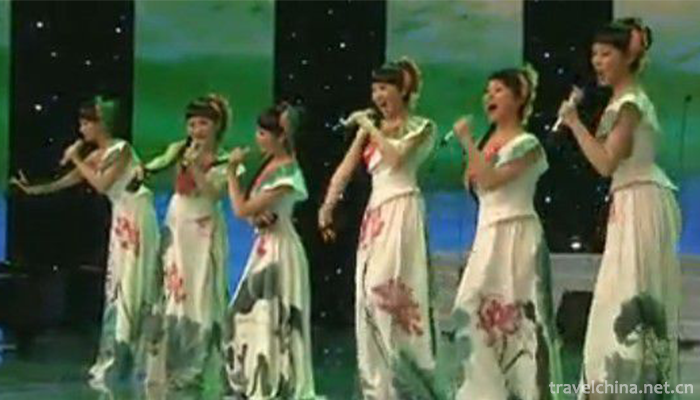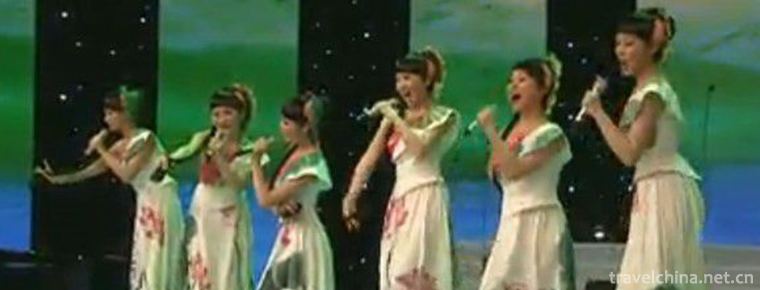Qianjiang Folk Songs
Qianjiang Folk Songs
Qianjiang folk song is a traditional folk song in Hubei Province. Popular in Qianjiang City, folk songs created by local working people in their work, life and customs. Its rich content, wide range of subjects, variety and unique style make relevant experts and scholars amazed. In a sense, Qianjiang folk song is also the weapon of struggle, the command of labor, the carrier of lyricism and the tool of entertainment for the local people.
On June 7, 2008, Qianjiang folk song declared by Qianjiang City of Hubei Province was listed in the second batch of national intangible cultural heritage list with the approval of the State Council. Heritage serial number: 581 II-82.
historical origin
Qianjiang folk song is one of the typical representatives of Chu Song legacy. In the Zhou Dynasty, she belonged to Zhou Nan, ranked first among the fifteen national styles, and was the main body of elegant music and Yan Yue; in the late Warring States Period, "Yang (Yang) A", which Quyuan and Song Yujin liked to talk about, was Qianjiang folk song; in "Four Sides of Chu Song", it sang "Chicken Song" of Qianjiang; in the Han Dynasty, "Chu Song Says Yan" and in the Wei and Jin Dynasties, Qianjiang folk song. Jiang folk song is an indispensable part. "Lower Voice" refers specifically to Qianjiang folk songs. Emperor Liang Jianwen of the Southern Dynasty said in The Book of Kings in Eastern Hunan: "Therefore, the jade emblem Jinju is scorned by my humble eyes, and the Ba people are more likely to listen to it."
artistic characteristics
Qianjiang folk songs are rooted in Qianjiang dialect. In addition to the Chu dialect of "Lun" and "some" in "Chuci" which is still the common "mantra" in this area, the tone color analysis of the language shows that Qianjiang, Tianmen and Xiantao (formerly Xuyang) are a color area, which is relatively independent of Jianghan because of less influence from the outside world. The plain has some influence. The Qianjiang River is the center of this color area, and the tone of the language radiates to the surrounding counties and cities to form variations. Its linguistic tone features are as follows: high tone is a color tone, which is classified as Yinping and deafening of the four tones in the tone of voice; middle tone is a nuclear tone, which is classified as Yang Ping; bass is a pillar tone, which is classified as upper tone.
Qianjiang folk songs mostly belong to three-tone folk songs. There are four kinds of common forms: 1. the symbolic trisyllable "152 (1 is treble)"; 2. the Gong trisyllable "315 (5 is bass)"; 3. the feather trisyllable "163 (1 is treble)"; 4. the twin trisyllable "652". These four prototypes of regular trisyllables are like the deformation of harmony transposition, and the free alternation and mutual penetration of these trisyllables lead to rich and colorful folk music. So Qianjiang has been known as "the land of folk songs" since ancient times. In Huainanzi Shuoshan, "Those who want beauty and harmony must begin with Yanga and Cailing." "Jiangling Music" in "Everyone stop to see, the voice is good." It is the praise of Qianjiang folk songs in historical books.
Representative repertoire
"Counting clams", "Urging" and "Where can I go back to my mother's house in my spare time", "Cucumber" and "Shixu Shoes", "There's a Small Place in China" by Wang Yan in 2011, and "Singing Your Qianjiang" by Zhang Wao, a Qianjiang singer, etc.
Inheritance Significance
1. Blind artists sing: Blind artists make a living by singing, absorbing a large number of folk songs and minor tunes into the song heritage;
2. Labor inheritance;
3. Inheritance combined with customs and festival customs;
Fourth, the inheritance of drama: Jingzhou Huagu Opera and Shadow Opera absorb and draw lessons from Qianjiang folk songs to spread into the opera.


-
1.Lijiang River
The Lijiang River, a branch of the upper reaches of the Guijiang River
Time 2018-10-12 -
2.Baishishan Scenic Area Baoding City Hebei Province
Baishishan Scenic Area, also known as Baishishan National Geological Park, is called "Xiaohuangshan" because its scenery resembles the Huangshan Mountain in Anhui Province.
Time 2018-11-24 -
3.Karajun Scenic Area
Karajun is Kazakh, meaning "the wilderness on the ridge". Karajun Mountain is a stretch of mountains from east to west. On both sides of it are hills with ravines and combs
Time 2018-12-12 -
4.Water Margin City Scenic Area of the Three Kingdoms
The Wuxi Film and Television Base of CCTV is the first large-scale film and television shooting and tourism base in China. Founded in 1987, it is the first theme park in China that combines film and t
Time 2018-12-18 -
5.Black Valley Scenic Area
Black Valley, National AAAAA Tourist Scenic Spot, National Forest Park, National Geopark, China's Best Leisure Mountain, China's Best Green Low Carbon Tourist Leisure Spot
Time 2019-01-13 -
6.Shenyang Weipo Skiing Ground
Shenyang Qiaopo International Skiing Resort is located in AAAA Scenic Area of Qiaopo in Shenyang, which is surrounded by mountains in the northeast direction and boundless forest sea.
Time 2019-02-08 -
7.Jinghe Opera
Jinghe Opera, a local traditional drama in Lixian County, Hunan Province, is one of the national intangible cultural heritage.
Time 2019-05-08 -
8.Larenbu and Jimenso
With vivid images, deep and solemn language and singing form, Larenbu and Jimenso described the love tragedy of the poor Larenbu and the pastor's sister Jimensoe, who developed from employer relations
Time 2019-05-10 -
9.Five major tunes in southern Shandong
The five major tunes in southern Shandong, also known as Tan Ma Diao and Tan Ma Diao, are traditional folk song suites that are active in Tancheng County, Linyi City, Shandong Province, with Tan Town
Time 2019-05-15 -
10.Suona Art
Suona art is a manifestation of traditional Chinese folk culture. In 2006, Qinyang City of Henan Province and Qingyang City of Gansu Province applied for intangible cultural heritage. Its basic musica
Time 2019-06-17 -
11.Ningbo Opera
Yong Opera is a local opera sung in Ningbo dialect of Zhejiang Province. Its musical tone belongs to Tanhuang. After 1938, this opera genre was officially called "Yongju" or "improved Y
Time 2019-07-14 -
12.Modern cheongsam
At the beginning of the 20th century, it was popular to wear a short jacket with trumpet shaped wide sleeves inside, and a long waistcoat without sleeves with the front and back of the coat reaching the ground. Since then, cheongsam has made some changes in the edge, sleeve
Time 2020-12-11